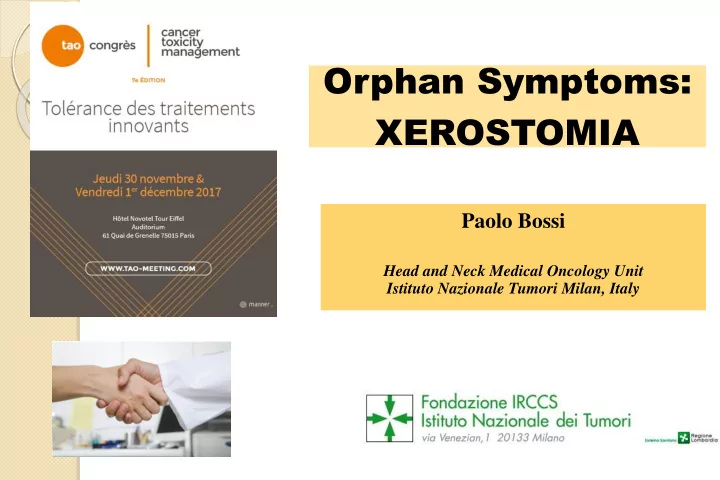

Orphan Symptoms: XEROSTOMIA Paolo Bossi Head and Neck Medical Oncology Unit Istituto Nazionale Tumori Milan, Italy
Conflict of Interest Participation in Advisory Boards: Roche, Merck, Mundipharma, Astrazeneca, BMS
AGENDA - Again an orphan symptom.. What is it? - Who decides the intensity of xerostomia? - The burden of the symptom(s) - Causes: RT – radioiodine Tx – systemic Tx (chemo - targeted agents- immune) – other drugs - Possible treatments
ORPHAN SYMPTOMS What is an orphan symptom ?… Difficult to be defined!
ORPHAN SYMPTOMS What is an orphan disease? A disease that has not been “adopted” by the pharmaceutical industry because it provides little financial incentive to make and market new medications to treat or prevent it. An orphan disease may be a rare disease or a common disease that has been ignored because it is far more prevalent in areas without market.
ORPHAN SYMPTOMS What is an orphan symptom ?… A neglected symptom? A symptom not assessed in any classification? A rare adverse event? T oxicity without effective treatment?
WHY XEROSTOMIA SHOULD BE AN ORPHAN SYMPTOMS? A neglected symptom? x
WHY XEROSTOMIA SHOULD BE AN ORPHAN SYMPTOMS? A symptom not assessed in any classification? x Evaluation of symptoms reported by 6 PRO measures: 1. ESAS 2. SDS 3. MDASI 4. EORTC QLQ-C30 V.3 5. Rotterdam Symptom Checklist (RSCL) 6. Memorial Symptom Assessment Scale (MSAS)
WHY XEROSTOMIA SHOULD BE AN ORPHAN SYMPTOMS? C O H R A P M H P A I N O N S
WHY XEROSTOMIA SHOULD BE AN ORPHAN SYMPTOMS? x A rare adverse event?
WHY XEROSTOMIA SHOULD BE AN ORPHAN SYMPTOMS? T oxicity without effective treatment?
ORPHAN SYMPTOMS What is an orphan symptom ?… I have no drug It is rare! to treat it! A symptom nobody would like to identify and to treat? I do not know how to classify!
WHICH GRADING OF XEROSTOMIA? CTCAE V 4.0 Another physician’s interpretation of subjective symptom? Do the objective assessment of CTCAE really measure the impact on everyday life?
SYMPTOM ASSESSMENT WITH RT Comparison between observer’s (physician) way to assess toxicity and patient evaluation with EORTC Quality of Life questionnaires
SYMPTOM ASSESSMENT WITH RT Sensitivity of observer = 74%; specificity = 90%
PRO-CISION IN SYMPTOM ASSESSMENT?
PRO-CTCAE LIBRARY
PRO-CTCAE LIBRARY
XEROSTOMIA: the burden of the problem cancer treatments cancer mucositis polipharmacy XEROSTOMIA Taste alterations T ooth Dysphagia Difficulty in chewing decay Oral cavity Reduced QoL malnourishment infection
TREATMENT -RELATED CAUSES Radiation Radioiodine therapy Chemotherapy Targeted therapies Immunotherapy
RADIATION-INDUCED XEROSTOMIA: Head & Neck Ca Serous acinar cells seem especially susceptible to radiation damage change in saliva composition (“sticky saliva”) One week post-radiation loss of 60-90% of salivary output has been documented. Late symptoms (>3 months): moderate-severe xerostomia in 60-75% with 2DRT and 40% with modern techniques
RADIATION-INDUCED XEROSTOMIA: PREVENTION Decrease the exposure of salivary gland tissues from excessively high RT doses Lancet Oncology 2011
XEROSTOMIA Dirix , Lancet Oncol, 2010
FIVE PHASE III TRIALS COMPARING 2D/3DRT VS IMRT Site Stage Overall RT RT dose, Gy CHT I/II Npts technique (tumor) III/IV 2D/RT IMRT Pow Naso 45 - 45 2D-RT vs IMRT 68 66-68 no IJROBP 20106 Kam Naso 56 - 56 2D-RT vs IMRT 66+/-BT 66+/-BT no JCO 2017 Nutting Oro- 80 2D-RT vs IMRT 65 65 Neo LO 2011 Hypo 23 14 (postop) (40%) 71 Gupta Oro- 12 32 70 66 Conc R&O 2014 Hypo 48 17 3D-RT vs IMRT Lar 11 Peng Naso 194 616 2D-RT vs IMRT 74+/-BT 74+/-BT Neo/con R&O 2012 422 c/adj 25
Xerostomia scores grades 2-4 A significant overall benefit in favor of IMRT HR of 0.76 (p< 0.0001) Locoregional control and OS Not significant benefit in favour of IMRT both for LRC and OS 26
RADIOIODINE TX- INDUCED XEROSTOMIA Before and 5 mo after radioiodine treatment: Reduction in salivary flow rate Change in composition (less protein and amylase) Worse subjective xerostomia inventory score J Nucl Med 2016
TARGETED TX- AND IMMUNOTX- INDUCED XEROSTOMIA DRUG INCIDENCE Everolimus 6% Dacomitinib 8-14% Multitargeted 4-12% angiogenesis inh Nivolumab/ 4-8% Pembrolizumab Ipilimumab negligible
MANY DRUGS CAUSES XEROSTOMIA! List of medications affecting salivary gland function and inducing xerostomia
MANY DRUGS CAUSES XEROSTOMIA! Consider, among all, the frequently prescribed opioids: morphine, fentanyl, tapentadol, tramadol …
AN ORPHAN SYMPTOM: NEEDS TO BE ADOPTED BY A THERAPY!
TREATMENT: mainstays 1) Cholinergic agonists: pilocarpin, cevimeline 2) Gustatory and masticatory stimulants 3) Lubrificants, saliva substitutes 4) Acupuncture 5) Hyperbaric Oxygen Therapy 6) Gene therapy
1) Cholinergic agonists: pilocarpin, cevimeline Stimulate muscarinic receptors on the surface of (residual) salivary gland cells Benefits: active both during and after RT; increase in unstimulated saliva; benefit on subj xerostomia Drawbacks: toxicities (bronchospasm, bradycardia, vasodilatation, diarrhea); short-lived efficacy T opical administration??
1) Cholinergic agonists: pilocarpin, cevimeline Oral Oncology, 2017
2) Gustatory and masticatory stimulants Acidic substances Purely symptomatic measures Limited studies
3) Lubrificants, saliva substitutes Widely used No need of residual salivary function Weak evidences Enzyme-enriched could be better High viscosity is better
4) Acupuncture Stimulation possible only with residual salivary function Weak or no evidence
5) Hyperbaric Oxygen Therapy Some studies suggest possible long-term benefit However: low number of patients, heterogeneous pt population, no risk-assessment on possible procancerogen effect
6) Gene Therapy Viral vector injection of gene able to partially restore salivary tissue Human aquaporin-1 gene transfer Preliminary data, phase I-II trial
Practically speaking … suggestions First step: symptomatic measures T est different saliva substitutes by individual patients to select the most effective one If not efficacious: in patients without risk factors try pilocarpine 5 mg t.i.d (10 mg if no adv events) Clinical trials on supportive care!
Conclusions An orphan symptom due to lack of treatments … Again, ask the patient what does it mean Burden of consequences Radiation is the main cause Treatment: salivary substitutes – cholinergic drugs Push to clinical trials in supportive care!
Thanks for your attention! paolo.bossi@istitutotumori.mi.it
Recommend
More recommend